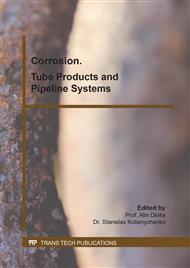[1]
N. O. Larrosa, R. Akid & R. A. Ainsworth, Corrosion-fatigue: a review ofdamage tolerance models, International Materials Reviews.63(2017)78-83.
DOI: 10.1080/09506608.2017.1375644
Google Scholar
[2]
Lihong Han, Ming Liu,Sheji Luo, et al,Fatigue and corrosion fatigue behaviors of G105 and S135 high-strength drill pipe steels in air and H2S environment, Process Safety and Environmental Protection 124 (2019)63-74.
DOI: 10.1016/j.psep.2019.01.023
Google Scholar
[3]
John A, Mullard and Mark G, Life-Cycle Cost Assessment of Maintenance Strategies for RC Structures in Chloride Environments, J Bridge Eng.17 (2012) 353-362.
DOI: 10.1061/(asce)be.1943-5592.0000248
Google Scholar
[4]
B.J. Wang D.K. Xu,S.D. Wang, et al,Influence of solution treatment on the corrosion fatigue behavior of an as-forged Mg-Zn-Y-Zr alloy, Int J Fatigue.120 (2019) 46-55.
DOI: 10.1016/j.ijfatigue.2018.10.019
Google Scholar
[5]
Lü Baotong, Zheng Xiulin, Lü Xiaoyan, Zheng X. Effects of Microstructure on Fatigue Crack Initiation and Propagation of 16Mn Steel[J]. Met. Trans. Vol.20A, 1989.413-419.
DOI: 10.1007/bf02653920
Google Scholar
[6]
Wei Jianfeng, Zheng Xiulin, Lu Baotong, P-S-N curve expression and life estimation of LY12CZ aluminum alloy incision parts. School of Materials Science and Engineering, Northwestern Polytechnical University, Xi'an, Shaanxi, China 1997.2.
Google Scholar
[7]
Wei Jianfeng, Lu Baotong, Zheng Xiulin, Curve expression and life estimation of the survival rate of normalized 45 steel incision parts. School of Materials Science and Engineering, Northwestern Polytechnical University, Xi'an, Shaanxi 1996.5.
Google Scholar
[8]
Xiulin Zheng, Zhen Li, Yongji Shi, et al, Fatigue performance of old bridge steel and the proceduresfor life prediction with given survivability, Eng Fract Mechanics. 53 (1996) 251-262.
DOI: 10.1016/0013-7944(95)00076-3
Google Scholar
[9]
Zheng Xiulin, Li Zhen, Lv Baotong, et al, Prediction of probability distribution of fatigue life of15MnVN steel notched elements under variable-amplitude loading, Int J Fatigue. 18 (1996) 81-86.
DOI: 10.1016/0142-1123(95)00081-x
Google Scholar
[10]
Gao Zhentong. Fatigue application statistics, Beijing, (1986).
Google Scholar
[11]
Wang Rong. Corrosion fatigue of metal materials, Xi'an, (2001).
Google Scholar
[12]
Rolfe S T, Barsom J M, Fracture and Fatigue Control in Structures, Prentice Hall, Englewood, Cliffs, U.S. (1975)205-231.
Google Scholar
[13]
Ishihara S, Saka S, Nan ZY, et al, Prediction of corrosion fatigue lives of aluminium alloy on the basis of corrosion pit growth law, Fatigue Fract Eng Mater Struct. 29 (2006) 472–480.
DOI: 10.1111/j.1460-2695.2006.01018.x
Google Scholar
[14]
Sriraman MR, Pidaparti RM, Life prediction of air craft Aluminium subjected to pitting corrosion under fatigue conditions, J Aircraft. 46 (2009) 1253–1259.
DOI: 10.2514/1.40481
Google Scholar
[15]
Hou NX, Wen ZX, Yu QM, Yue QM, Application of a combined high and low cycle fatigue life model on life prediction of SC blade, Int J Fatigue. 31 (2009) 616–9.
DOI: 10.1016/j.ijfatigue.2008.03.021
Google Scholar
[16]
Cui L, Scholz A, Von Hartrott P, Schlesinger M, Lebensdauervorhersage–Entwicklung von Modellen zur Lebensdauervorhersage von Kraftwerkbauteilen unter thermisch-mechanischer Kriechermüdungsbeanspruchung, vol. 888. Frankfurt/Main, Germany: Forschungsvereinigung Verbrennungskraftmaschinen (FVV); 2009, Final report of the project Nr. 895.
Google Scholar
[17]
Bernard Fedelich, Hans-Joachim Kühn, Birgit Rehmer, et al, Experimental and analytical investigation of the TMF-HCF lifetime behavior of two cast iron alloys, Int J Fatigue. 99 (2016) 266-278.
DOI: 10.1016/j.ijfatigue.2016.11.013
Google Scholar
[18]
Zheng Xiulin. Quantitative theory of metal fatigue, Xi'an, (1984).
Google Scholar
[19]
Zheng X L, Overload effect on fatigue crack initiation behavior and life prediction model of low carbon steels, Int J Fatigue, 17(1995) 331-337.
DOI: 10.1016/0142-1123(95)99733-q
Google Scholar
[20]
Zheng Xiulin, Wang Hong, Yan Junhui, et al, Material fatigue theory and engineering application, Beijing, (2013).
Google Scholar
[21]
International Forum for Physical Metallurgy of IF Steel. Tokyo, (1994).
Google Scholar



